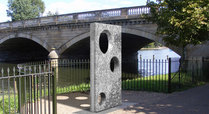Entries and shortlist
In 2010, we launched an international design competition to find new designs for drinking fountain in the Royal Parks.
We received over 150 submissions from designers, architects, engineers, students and members of the public from 26 countries including Australia, Singapore, Russia, South Korea and the US. View some of these designs in the gallery.
The shortlist
The designs were judged on aesthetics, robustness for life in a public park, ease of maintenance and installation, sustainability and environmental impact and affordability.
The Trumpet (Winner)
Ben Addy, Moxon Architects
Trumpet is now located in Kensington Gardens
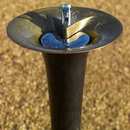 Trumpet is intended as a formally elegant addition to the repertoire of urban furniture already provided in London’s Royal Parks. It is hoped that the design will be understood as being understated and accessible. Above all, it is intended as a playful, robust and appropriate piece of public design.
Trumpet is intended as a formally elegant addition to the repertoire of urban furniture already provided in London’s Royal Parks. It is hoped that the design will be understood as being understated and accessible. Above all, it is intended as a playful, robust and appropriate piece of public design.
The body of each fountain would be cast as a single element – in the same manner as a church bell – using a bronze alloy cast between male and female moulds. This piece would be supported by a painted carbon steel base, cast into the ground. Runoff water is caught by the flared ‘bell’ at the top and guided through the centre of the fountain to a drain at the bottom of the structure.
As water drains down the body of the fountain the open ‘trumpet’ form playfully exposes the user to the sound of the water running down through the structure – with splashes, trickles – and hopefully the occasional gurgle – the acoustic properties of the design provide immediate and intriguing feedback. The same properties might also encourage children to put their ear to the fountain (to listen for the sea perhaps) or hear their own voice echoing through and being distorted by the hollowed-out form.
In considering the Grade 1 listed environments in which the fountain must be placed it is vital that it exists as a high quality, contemporary piece of design that is compatible with a wide range of existing items of design, from many periods and in many styles. Therefore the single most important consideration in the design of Trumpet has been to ensure that its aesthetic qualities make it suitable for incorporation into important and sensitive locations – historic, modern, urban or pastoral whilst also suiting modern means of manufacture and regulations.
Watering Holes (Winner)
Robin Monotti Architects with Mark Titman
Watering Holes is now located in Green Park.
 Watering Holes is a sculptural granite slab with polished holes offering the user a grotto-like experience with framed views. The water is activated by stainless steel buttons set in brushed steel plates on the sides of the slab.
Watering Holes is a sculptural granite slab with polished holes offering the user a grotto-like experience with framed views. The water is activated by stainless steel buttons set in brushed steel plates on the sides of the slab.
The experience of inserting one’s head into these watering holes is playful yet deeply rooted in ancient and popular British culture. Monolithic and timeless, these slabs echo the silent standing stones of yore. They also act like the seaside photo boards of more recent holiday experiences. The free-standing and open nature of the fountains with their intimate holes that contain and frame the user’s head and face connect the user with both the surroundings and the action of drinking in a way that an open fountain could not.
The fountain is perforated with three circular holes. The three holes relate to the drinking heights of adults (the higher one), children or wheelchair users (the middle one), and pets (the lowest hole).
To the lower side of each circular hole will be the mouth of a water jet that is controlled by a respective push button on the side that allows the water to flow when pressed.
The water flows down the circular cut, and the circle’s chamfer prevents any splashing to reach the person drinking. Having reached the lower section of the circle, the water flows down the face of the fountain to be collected in a trough at the bottom through which the water is drained.
The main block is to be made of sawn Cornish granite, which will give the fountain a smooth and dappled colour. An anti graffiti sealant is applied to the face to render the concrete water-proof and allow any graffiti to be removed.
The positioning of the fountains within the Royal Parks will be considered with reference to the views that will be framed by the circular holes when in proximity of the fountain. The simplicity of the shapes of the rectangle for the main body, and the circle for the hole are designed to give the fountain an easily recognizable identity that can be perceived from a distance as a sculptural element within the park.
Water re Cycle
Giulio Dario Marchesi and Valerio Panella
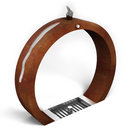 The design of the drinking fountain encloses all the feelings about saving environment and promoting a responsible use of waterhe corten steel ring evokes the natural (re)cycle of water and is itself a symbol of reuse of such an important resource. A cut in the steel ring guides the waste water from the taps (both the drinking one and the separate one used to fill bottles) to a bowl at the base of the fountain where it's collected in a bowl so dogs can drink, before it goes to the final drainage.
The design of the drinking fountain encloses all the feelings about saving environment and promoting a responsible use of waterhe corten steel ring evokes the natural (re)cycle of water and is itself a symbol of reuse of such an important resource. A cut in the steel ring guides the waste water from the taps (both the drinking one and the separate one used to fill bottles) to a bowl at the base of the fountain where it's collected in a bowl so dogs can drink, before it goes to the final drainage.
WaterBow
Anja Goetz, Christoph Fleckenstein, Julius Baasner, IONDESIGN GmbH Berlin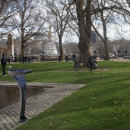 The shape of our drinking fountain is based on archetypal structures. The pedestal underlays a saucer-type basin. At its margin the inflow of fresh water is placed. The drinking fountain´s body is characterized by reduction and aperture. The bowl opens its body to an open ring. The occurrence of blockage caused by foliage or debris is warranted and no place of deposit is given. Following its parabolic course the water jet targets the centre of the ring, strikes at the inner pillar and drains off to the pedestal of the fountain.
The shape of our drinking fountain is based on archetypal structures. The pedestal underlays a saucer-type basin. At its margin the inflow of fresh water is placed. The drinking fountain´s body is characterized by reduction and aperture. The bowl opens its body to an open ring. The occurrence of blockage caused by foliage or debris is warranted and no place of deposit is given. Following its parabolic course the water jet targets the centre of the ring, strikes at the inner pillar and drains off to the pedestal of the fountain.
At this base point the residual water will be collected in a drinking pond for animals, before it will drain completely. The exposed flow of the water makes it possible to scoop or drink water from different positions: near to the tap, where the water jet ascends, at its height or at its fall. Due to the parabolic flow of the jet the visitor can bottle water easily.
Softroom
Christopher Bagot
The arching form not only reflects the history of the Tiffany Foundation, but creates a sculptural form that can exist harmoniously within its environment, a point of local interaction within the larger scale of the parks. The fountain offers two fountains to the visitor, at high and low level, to ensure universal accessibility. A wide rim around the basin ensures the user may grip and steady themselves whilst drinking from the fountain. The elegant form is intended to inspire a moment of delight in the visitor. From the urban surrounds of St. James’s Park to the open, natural landscape of Richmond Park, the design of the fountain is intended to sit comfortably in all scales of spaces, providing a useful function for the parks’ visitors.
The fountain offers two fountains to the visitor, at high and low level, to ensure universal accessibility. A wide rim around the basin ensures the user may grip and steady themselves whilst drinking from the fountain. The elegant form is intended to inspire a moment of delight in the visitor. From the urban surrounds of St. James’s Park to the open, natural landscape of Richmond Park, the design of the fountain is intended to sit comfortably in all scales of spaces, providing a useful function for the parks’ visitors.
The design is of the appropriate high standard for a Royal Parks project supported by the Tiffany & Co. Foundation, and in line with their stated aim to ‘protect the beauty of nature and the creativity of human nature’.
Precious Drop
Guy Matthews and Adelais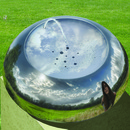 The starting point is a single bead of water resting on the surface of a leaf, which is part of a landscape. We want to communicate the preciousness of this drop of water, so we set it on top of a stone plinth, as if it was a sculpture, warranting our attention. This way the fountain has two main components: the bead and the plinth.
The starting point is a single bead of water resting on the surface of a leaf, which is part of a landscape. We want to communicate the preciousness of this drop of water, so we set it on top of a stone plinth, as if it was a sculpture, warranting our attention. This way the fountain has two main components: the bead and the plinth.
The bead is mirror polished spun stainless steel and designed as a reflective body, with the purpose to enhance the surrounding landscape and to highlight water as an integral part of the environment and of ourselves. The top of the bead is a smooth and seamless basin, where the water will be drunk as well as drained efficiently, and it will create a captivating effect with the convex and concave reflections of the material.
The plinth is an archetypal simple shape, square in plan so as to contrast with the curvature of the bead. Naturally derived Techlite cast stone is used as a sustainable option with the quality, texture and appearance of Portland stone, London’s historic stone. The plinth will be treated against staining and lichen growth, yet it will mature over the years in order to mellow and blend into the environment.
